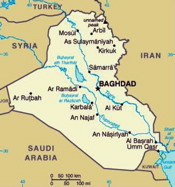BASRA, Iraq -- It seemed like such a small thing. Royal Air Force security troops patrolling the outskirts of Basra air station in southern Iraq on Dec. 17 leaped out of their new Mastiff armored trucks in order to scout out a bridge before the lumbering blast-proof vehicles crossed. One of the 34 Squadron troopers noticed something he didn't recall seeing before: a crack in the concrete near the far side of the bridge. He pointed it out to Flight Lt. Edward Cripps, who eyed the idling Mastiffs, their drivers waiting for the all clear. This is what happens, Cripps mused aloud, when you repeatedly drive 30-ton trucks over a bridge designed for much lighter vehicles. "We'll have to keep an eye on this," he said. But for now the bridge was sound, and an officer gestured for the Mastiffs to cross. A small thing, to be sure, but the over-burdened bridge is just one consequence of the changing nature of British military operations in southern Iraq. Two years ago, nimble, lightly-equipped British forces pursued a counterinsurgency strategy grounded in decades of operational experience -- and with unusual effectiveness. So much so that heavy, aggressive U.S. forces adopted British methods when they launched their much-vaunted "surge" campaign to retake Baghdad from insurgents.
For British Forces in Iraq, Protection Means Loss of Effectiveness

